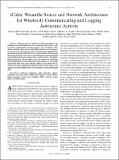iCalm: Wearable Sensor and Network Architecture for Wirelessly Communicating and Logging Autonomic Activity
Author(s)
Dobson, Kelly; Goodwin, Matthew; Eydgahi, Hoda; Wilder-Smith, Oliver; Fernholz, David; Kuboyama, Yuta; Hedman, Elliott Bruce; Poh, Ming-Zher; Picard, Rosalind W.; Fletcher, Richard R; ... Show more Show less
DownloadFletcher-2010-iCalm_ wearable sens.pdf (2.090Mb)
PUBLISHER_POLICY
Publisher Policy
Article is made available in accordance with the publisher's policy and may be subject to US copyright law. Please refer to the publisher's site for terms of use.
Terms of use
Metadata
Show full item recordAbstract
Widespread use of affective sensing in healthcare applications has been limited due to several practical factors, such as lack of comfortable wearable sensors, lack of wireless standards, and lack of low-power affordable hardware. In this paper, we present a new low-cost, low-power wireless sensor platform implemented using the IEEE 802.15.4 wireless standard, and describe the design of compact wearable sensors for long-term measurement of electrodermal activity, temperature, motor activity, and photoplethysmography. We also illustrate the use of this new technology for continuous long-term monitoring of autonomic nervous system and motion data from active infants, children, and adults. We describe several new applications enabled by this system, discuss two specific wearable designs for the wrist and foot, and present sample data.
Date issued
2010-03Department
Massachusetts Institute of Technology. Department of Electrical Engineering and Computer Science; Massachusetts Institute of Technology. Media Laboratory; Program in Media Arts and Sciences (Massachusetts Institute of Technology)Journal
IEEE Transactions on Information Technology in Biomedicine
Publisher
Institute of Electrical and Electronics Engineers (IEEE)
Citation
Fletcher, R.R. et al. “iCalm: Wearable Sensor and Network Architecture for Wirelessly Communicating and Logging Autonomic Activity.” IEEE Transactions on Information Technology in Biomedicine 14.2 (2010): 215-223. Web. 3 Feb. 2012. © 2010 Institute of Electrical and Electronics Engineers
Version: Final published version
Other identifiers
INSPEC Accession Number: 11177391
ISSN
1089-7771
1558-0032